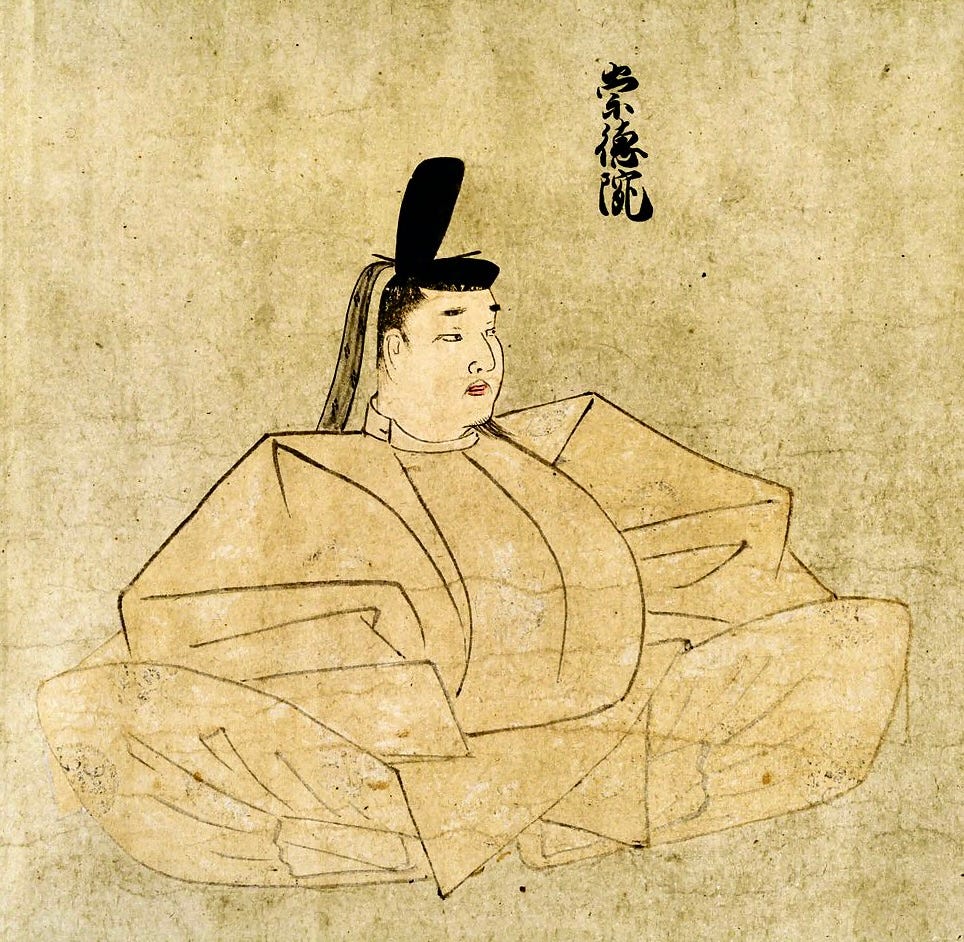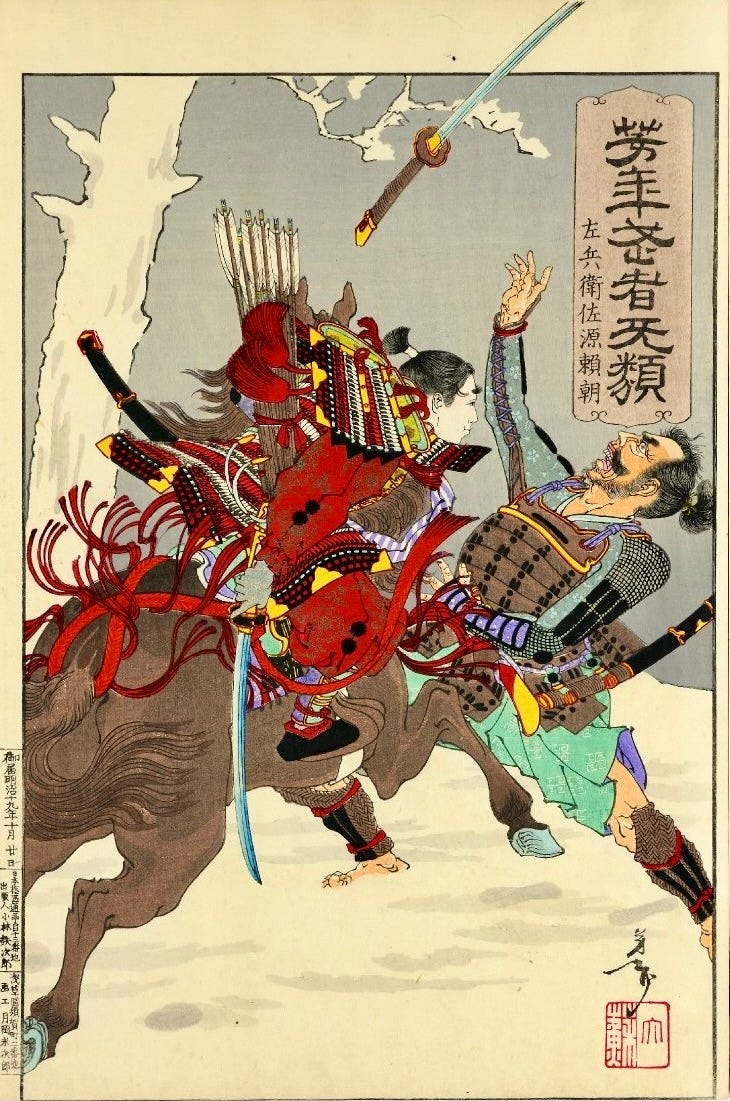Hell Hath no Fury like an Emperor Scorned
Japan loves threes. Three Great Beautiful Places. Three Great Night Views. Three Great Mountains. In this three article series, I introduce you to Japan’s Three Great Vengeful Ghosts.
Vengeful Ghost #2 — Emperor Sutoku

The central Heian government in Kyoto was beginning to fall apart by the 12th century. A succession dispute in 1156, known as the Hogen no Ran, turned into a fierce battle between the younger Emperor Go-Shirakawa and his older brother, the retired Emperor Sutoku.
This ended badly for Sutoku, and he was banished in disgrace as a criminal to Sanuki (Kagawa Prefecture) on the island of Shikoku.
While under house arrest in Sanuki, Sutoku applied himself to Buddhist study. He made offerings for the souls of those who had died in battle. He reflected on his life and prayed for his rebirth in the Buddhist Pure Land. And he spent months diligently writing out the five main Buddhist texts, or sutras. Some accounts claim that these sutras were written in his blood, so dedicated was he to the purifying of his soul.
Sutoku sent these painstakingly prepared sutras to Kyoto as an offering for a temple. First, though, they were presented at the Imperial Court.
The suspicious Emperor Go-Shirakawa took one look at them and wondered aloud, “Has Sutoku sent us a curse?!” Without even opening them, he had the sutras returned to Sutoku.
This blatant disrespect sent Sutoku into a rage. “If it’s a curse you want, a curse you shall get!” He gnawed his tongue, and with his blood he wrote this curse, “I shall become a mighty demon! I shall cause the Emperor to be made low, and the lowly peasant to be exalted!”
After this, Sutoku changed. He fell into a deep melancholy. His hair, beard, and nails went untrimmed, and he lived out his life in lonely exile away from his beloved Kyoto. Many say he came to appear more like a goblin of the mountains than the once mighty emperor of Japan.

Back in the capital, Emperor Go-Shirakawa retired in 1158, but he continued to keep a tight grip on power through the reigns of the next five emperors — each of whom was one of his sons or grandsons.
In 1164, Sutoku died.
As a final insult, Go-Shirakawa paid no respects and held no funeral services for his older brother, the former Emperor Sutoku. No royal tomb was built for him in Kyoto. He was banished even in death.
The governor of Sanuki Province saw to Sutoku’s funeral.
Birth of a Vengeful Ghost

Twelve years after Sutoku’s death, bad things started happening in the capital.
In 1176, Go-Shirakawa was shaken by the sudden deaths of four of his closest allies in the court. They had died one after the other.
The following year, the powerful warrior monks of Mount Hiei raised their heads, threatening the authority of the emperor. A brazen plot to overthrow the influential Taira clan was exposed. Worse, a massive fire reduced one third of the city of Kyoto to ashes.
A prominent court noble recorded in his diary that all these events were surely the work of the disrespected and banished ghost of Emperor Sutoku.
From that time on, the name Sutoku appeared often in the writings of the aristocracy in connection with any unfortunate event.
At last, the fearful and superstitious nobles pressured Go-Shirakawa to allow Buddhist memorial services to be held for the comfort of Sutoku’s spirit.
He acquiesced.
A mausoleum was built for Sutoku on the site of the Hogen no Ran battle. This was later incorporated into Hirano Shrine, which still stands in Kyoto today.
“Emperors Made Low”

While the nobles in Kyoto were enjoying their sophisticated culture, fine clothing, and poetry, the samurai in the countryside were gradually gaining power. Wars were fought between rival clans, and in 1184, the victorious warlord Minamoto no Yoritomo set up his shogunate in Kamakura. This marked the beginning of the feudal age that lasted until the mid-19th century.
For nearly 700 years, the emperor was reduced to a mere figurehead, cloistered in his palace in Kyoto. All power was held by the shogun.
Sutoku Becomes a Guardian Deity
In the early 13th century, Go-Shirakawa’s great grandson, the retired Emperor Tsuchimikado, was banished to Shikoku Island. He made a point to visit Sutoku’s grave to commiserate with his spirit, and to comfort him by playing his lute. Like Sutoku before him, Tsuchimikado was troubled and lonely, far from his loved ones in Kyoto.
That night, Sutoku appeared to Tsuchimikado in a dream, consoling him and promising that he would look after and protect his family.
Although Tsuchimikado’s family lost power after his exile, about 20 years later through an unexpected turn of events, the baby that Tsuchimikado was forced to leave behind in Kyoto became the emperor Go-Saga. Sutoku’s promise was remembered.
In the 14th century, the powerful samurai Hosokawa Yoriyuki also paid a visit to Sutoku’s grave on Shikoku and made offerings for his happiness in the afterlife. He then prayed for Sutoku’s guidance and help in conquering the island. He succeeded in subjugating Shikoku, and thereafter Sutoku became the guardian deity of the Hosokawa clan.
Sutoku’s Spirit Lives On
In 1868, Emperor Meiji took the throne, ending feudalism and long centuries of samurai rule. Power was restored to the emperor.
The teenage emperor, not wanting any trouble from unappeased angry ghosts, sent an imperial envoy to Sanuki to bring the spirit of Sutoku to Kyoto. Back in his former capital, Sutoku was deified and enshrined at Shiramine Shrine.

On the 800th anniversary of Sutoku’s death, just prior to the 1964 Tokyo Olympics, Emperor Hirohito sent emissaries to Sutoku’s tomb in Kagawa Prefecture. On the emperor’s orders, they honored Sutoku with an imperial memorial service and prayed for the repose of his spirit. Like his grandfather the emperor Meiji, Hirohito wanted no trouble from an aggrieved Sutoku.
The 1964 Olympics were a milestone in post-war Japan, bringing the country to the world stage as a peaceful, progressive, and prosperous nation.
Perhaps Sutoku’s spirit finally was at peace.
Here is part one of this series about Taira no Masakado, the ghost who haunted Tokyo.
Part three is the story of my favorite ghost, Sugawara no Michizane.
If you have questions about Japan or suggestions for articles, please add them in the comments. For more photos and information on Japan, follow me on instagram at: https://www.instagram.com/more_than_tokyo/




